
Home » Journal Articles » Thoughts & Opinions » When Is It YOUR Art?
Since most art historians agree that while Rodin is undoubtedly world famous as a sculptor, other artists carved most if not all of his marble pieces. That gave us the idea of putting the above question to six of our members. Here is how they answered it.
Arliss Newcomb
Jim Tobin
Lee Gass
Michael Binkley
Michael Yeaman
Tracy Powell
August Rodin
Speaking for myself, as an artist who carves from rough stone to a finished work, with no other person’s help or input, I can claim the piece is totally mine. But on the other hand, on my trips to China, I design and shape a form for the Master Carver to work.
Sometimes I am able to spend the time in his workshop, roughing out a piece for him to finish for me. I always tell a buyer the history of each sculpture. I believe in all honesty, it is still my work and would sign it with my signature. Mind you, in the 30 years I have been working in stone, with over 400 finished carvings in my portfolio, only 10 have been finished in China. Maybe the naysayers will forgive my trespasses!
Artists have been sending their designs to Italy, China and elsewhere to be worked for many years in stone, glass, bronze and other media. I have often heard, “Well, he or she is a well-known artist and very busy, so they have helpers.” So does that mean if you are famous it’s OK to say it’s totally your work, but if you’re someone like myself, it’s not honest? Rather a double standard, wouldn’t you say?
I take pride in the fact that I am able to transform an idea into a completed work, pleasing to view, touch and display. As long as I still have the passion to accomplish this, I count myself lucky.
Keep moving, keep carving and find joy in your creation.
Sculpt Proud.
Arliss

Nevertheless, I think it’s important to recognize those who have slaved and fretted over a sculpture for weeks in a dusty cold workshop and myself who can slave and fret over a design for weeks, but often hasn’t done the actual carving. My compromise solution is twofold: first, I sign the pieces I have created and processed myself with my name but secondly those sculptures that I have hired carved (or if someone else has worked on my design) I have labeled “Imré” which in my Hungarian grandfather’s namesake and represents my collaborative art.
Today I want to carve my own designs. Why? Because I finally have more free time and because, I also really do enjoy the process. I love moving stone and seeing the final form emerge before patiently polishing it to a brilliant shine. I have an innate need to shape hard things like stone or metal that drove me to sculpture in the first place. Now that I finally have designs worthy of my personal time and also because I plan to employ designs that capture the spirit of a particular rock, I want to carve my own, albeit fewer and smaller sculptures. Will the quality of my designing diminish if I now spend so much of my free time carving? Probably. Do I care? Nope. I do what makes me happy!
Usually when I imagine sculptures, that is all that happens – – I imagine them and then move on to other things. What I imagine is my own. But is it? Why do I keep imagining things that remind me of Brancusi, Moore, Hepworth, and many others?
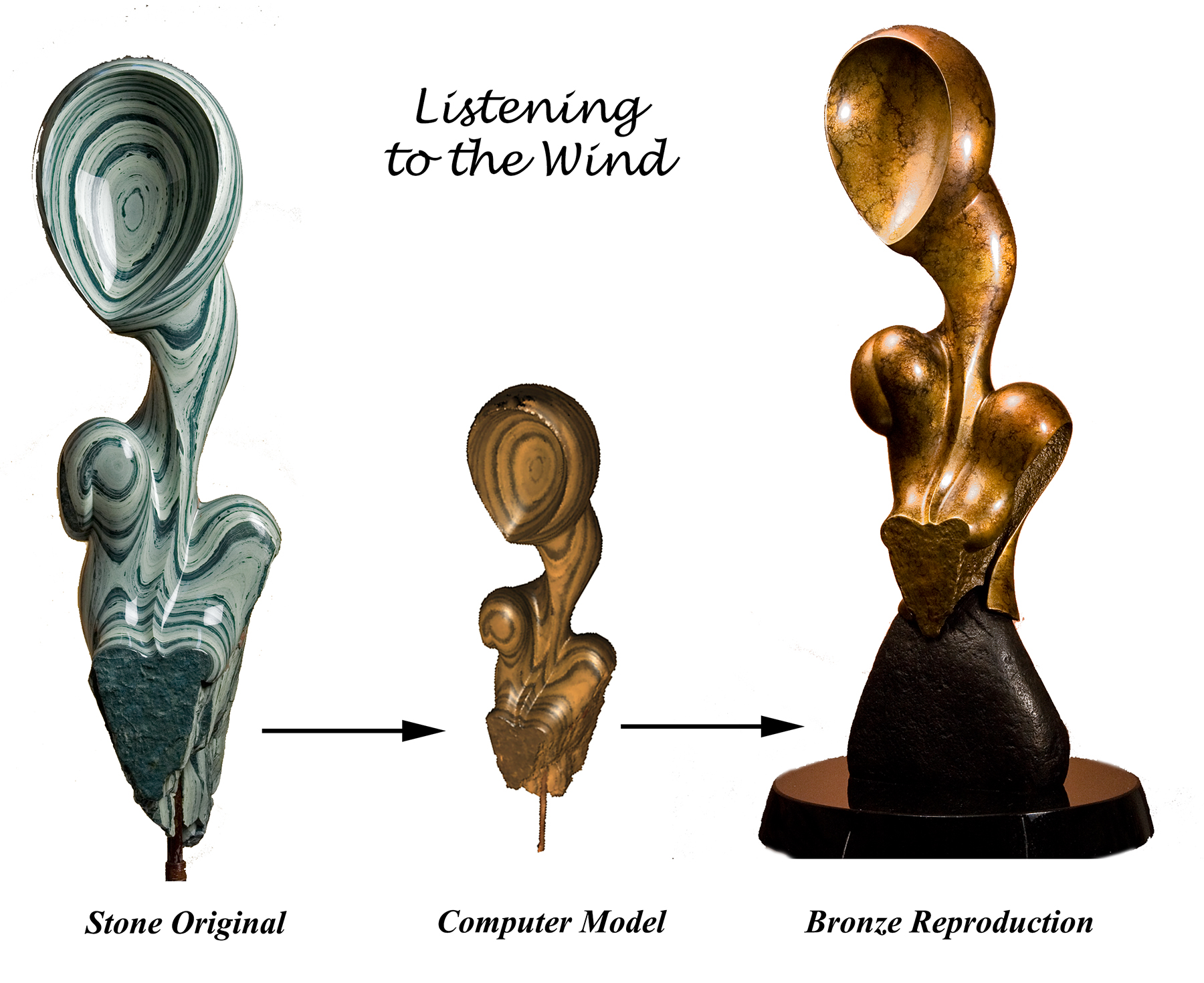 When I find a stone in nature and carve it, or buy it and carve it, it is clearly mine if the design is mine. If it’s a copy I have to say it’s a copy and it’s OK. But when I create the form and do the work, there’s nothing to argue about. Only if others help me can questions of authorship be important. Here are a couple of examples.
When I find a stone in nature and carve it, or buy it and carve it, it is clearly mine if the design is mine. If it’s a copy I have to say it’s a copy and it’s OK. But when I create the form and do the work, there’s nothing to argue about. Only if others help me can questions of authorship be important. Here are a couple of examples.
Rodin created sculptures in clay. Assistants reproduced them in plaster, which Rodin modified, and so on, until the last plasters went to a foundry and/or a marble carver for production. I think of the marbles and bronzes as Auguste Rodin’s sculptures, regardless of the number of assistants he employed. Brancusi worked for Rodin for a while, but left because he wanted to do his own work and I think he did.
Up till now, I’ve mainly done it like Brancusi and haven’t had to worry about it. If I carve a sculpture in stone, then make a bronze series from it with or without changing the scale, I’m like Rodin. In the case of my Listening to the Wind, I made the pattern for casting from a ¾-scale CNC reduction of the stone original. Besides making the pattern, ordering new casts, and selecting patination, I haven’t had anything to do with bronzes. I call them mine and enjoy the profit from selling them, and we get to keep the original.
I imagine all sorts of ways to get out of work – – assistants, CNC milling, Third World stone carvers, roughing out at the quarry. Mainly I do it myself like Brancusi and don’t worry about it. When I do it like Rodin I celebrate the fact that assistance is available and move on.
Maybe I’m just a dreamer. Maybe I just like to work. Maybe I’m getting old, and want to get as much work in as I can before I die.
Michael Binkley How much of your hands-on work is necessary to call it yours and for you to be able to ethically sign the artwork?
Up until recently, I have carved each and every one of over 10,000 original stone sculptures from conception to finish. However, I realize that in the history of art, this is an anomaly.
I think that the sculptors of our generation, indeed most of us with NWSSA are of the same ilk as me. We carve our sculptures from start to finish. But hundreds of artists who are credited as stone sculptors hardly carve even one of their stone creations. For example, Bernini, Canova, Rodin, and arguably Michelangelo created their sculptures in clay or plaster. The sculptures were then sent to a marble studio, where artigiani (Italian for craftsmen trained to copy and enlarge) transferred the sculptures to stone. Artists are still having this done today in thousands of stone studios around the world by human or mechanical copying machines.
In my opinion, the artist takes full credit for the conception of the sculpture whether it is designed virtually with a 3D modeling program, it is modeled using a medium such as clay, plaster or foam, or if it is carved directly to stone. There has never been an issue with bronze sculptors who create their sculptures in a different medium and then have a foundry cast, and often scale up their sculptures in bronze. These sculptors often never touch the bronze, except to sign it when it is complete. This process has existed for centuries in the realm of stone, yet suddenly there is a discussion as to whether an artist has an ethical right to sign their stone sculpture if they have not had a hand in t
he carving p
rocess. The conception of the sculpture must come from the artist. Transferring the idea from one medium to stone, whether done by the artist, a craftsman or a CNC machine, is purely academic.
There is a huge advantage to the artist who can conceive AND carve their own work. This is where we contemporary stone sculptors who carve our own work excel. We are inspired by the shape of the original block, the colours and patterns of the stone and we can adjust our composition on the fly to accommodate a previously unforeseen flaw in the block. These are issues that a machine or a craftsman cannot address, as these methods are constricted by the artist’s submitted design.
The above example illustrates my point.
Michael Yeaman How much of your work is needed on a sculpture to call it yours?
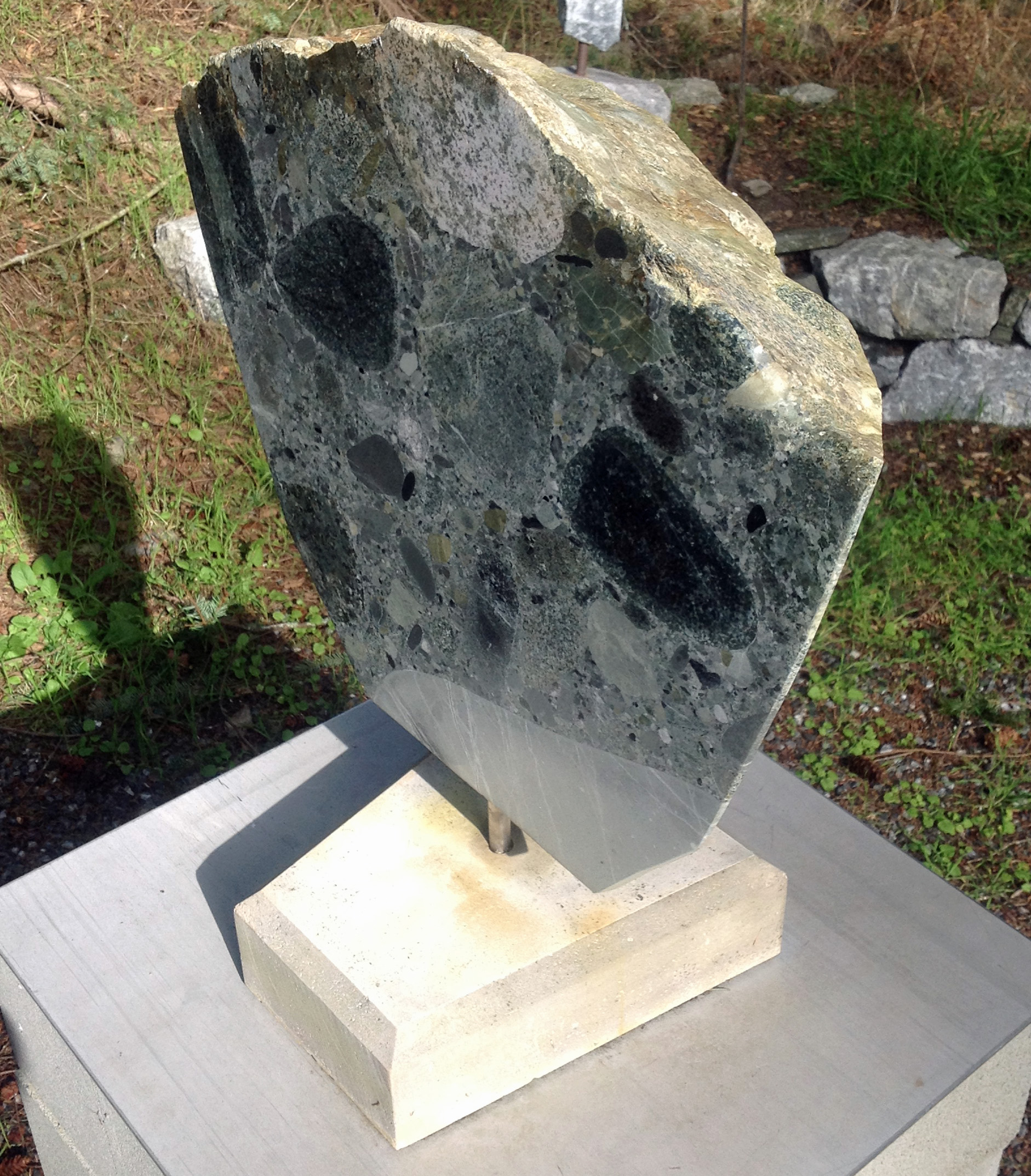
The amount of “work” on a stone to transform it into a piece of art has varied across time and taste. For me, the selection of the stone, before any direct sculpting has occurred can be as important as any “work” done on the stone afterward.
From ancient to post-Renaissance times, sculptors would spend long periods at stone source locations to confirm the carving quality of the stone, before any significant time was spent on its sculpting. Direct involvement by the sculptor in the quarrying process was not uncommon. For them, determining a stone’s mineral purity and mechanical qualities were often the driving factors to ensure it would confidently yield to the sculptor’s tools. For myself, my stone selection process is equally important; however my selection process is usually driven by my belief in the stone’s compelling Geologic story. Igneous, metaphoric and sedimentary rocks can all contain such stories. To know the story of the stone is the first step in its transformation to art. When I stand in front of a compelling stone my first thoughts are what shape/form/modification can I undertake to bring out its story.
Simple Abstract Forms are often the best choice for stones with complex stories. Their complexity is often reflected in their colors, layers and varied mineral makeup. By forming these complexities into abstract shapes, both the stone’s original geologic nature and an aesthetically pleasing composition can be achieved. Therefore the amount of “work” I do on a sculpture to call it mine will vary significantly by the effort I believe is necessary to achieve these two goals. I often struggle as to how much form to introduce to a geologically intriguing piece of stone.
Finally, I also believe that to call a sculpture fully mine, I will have had to perform all the steps of its journey, from its arrival on my carving pad, to its shaping, texturing, polishing and mounting on its plinth. Anything short of this simply makes me one of a number of participants in the final work.
Let history decide the importance of my views, I remain comfortable in my geologically-compelling, sculpting skin.
When is it your art? When you are making it, including the time it only lives in your dreams, either before or after the making. What has this idea to do with your question? I think an artist’s relation to her, or his, artwork is a very personal, and quirky thing. The artist’s purpose in doing the work may or may not have any connection to whoever looks at it, or fondles, or buys it. And those relationships may vary a lot, depending on the context. If you make a sculpture to sell, you are looking beyond the work to a payday, sometime in the future, and may never know what the purchaser has in mind, if indeed it ever sells. If you are making something for a client, as a commission, your work is greatly influenced by what the client wants, possibly to the extent that it really isn’t your artwork at all, but just a job. If you are making a gift for a friend or family member, there will be a very special sharing, unique to your relationship. If you make a sculpture to be on public display, your relationship to the work is similar to a personal gift, but you can’t know what the viewers may think of it.Returning to the question about signatures, I can only offer my opinion, which has changed over time. In the beginning, I signed every piece, I guess because that’s what my friends and teachers were doing. Most of those carvings were for galleries or exhibits, and usually the people in charge wanted signatures on the work, although I was completely unknown, and my name had no value at all. It was just the thing to do. As I studied and learned and carved, year after year, I found that many of the sculptures I came to admire most were the old ones, Greek, Egyptian, Celtic, Hindu, Buddhist, and Native American, and had no names attached. Anonymous. The sculptures sang to me, without any reference to any personality, but as if they were alive themselves.
Signatures, if there were any, seemed to be annoyances, or even serious detractions. So I changed my ideas, and now I only sign a piece if the client demands it. I am nobody, and my signature is nothing, but I hope my carvings will sing to somebody.
The other question, about doing your own work, or hiring it out, is also a matter of personal opinion. Here is mine: I do all my own work, because I enjoy carving so much, I want to have all the fun myself. I don’t care what others do.
RODIN AND HIS PRACTICIENS

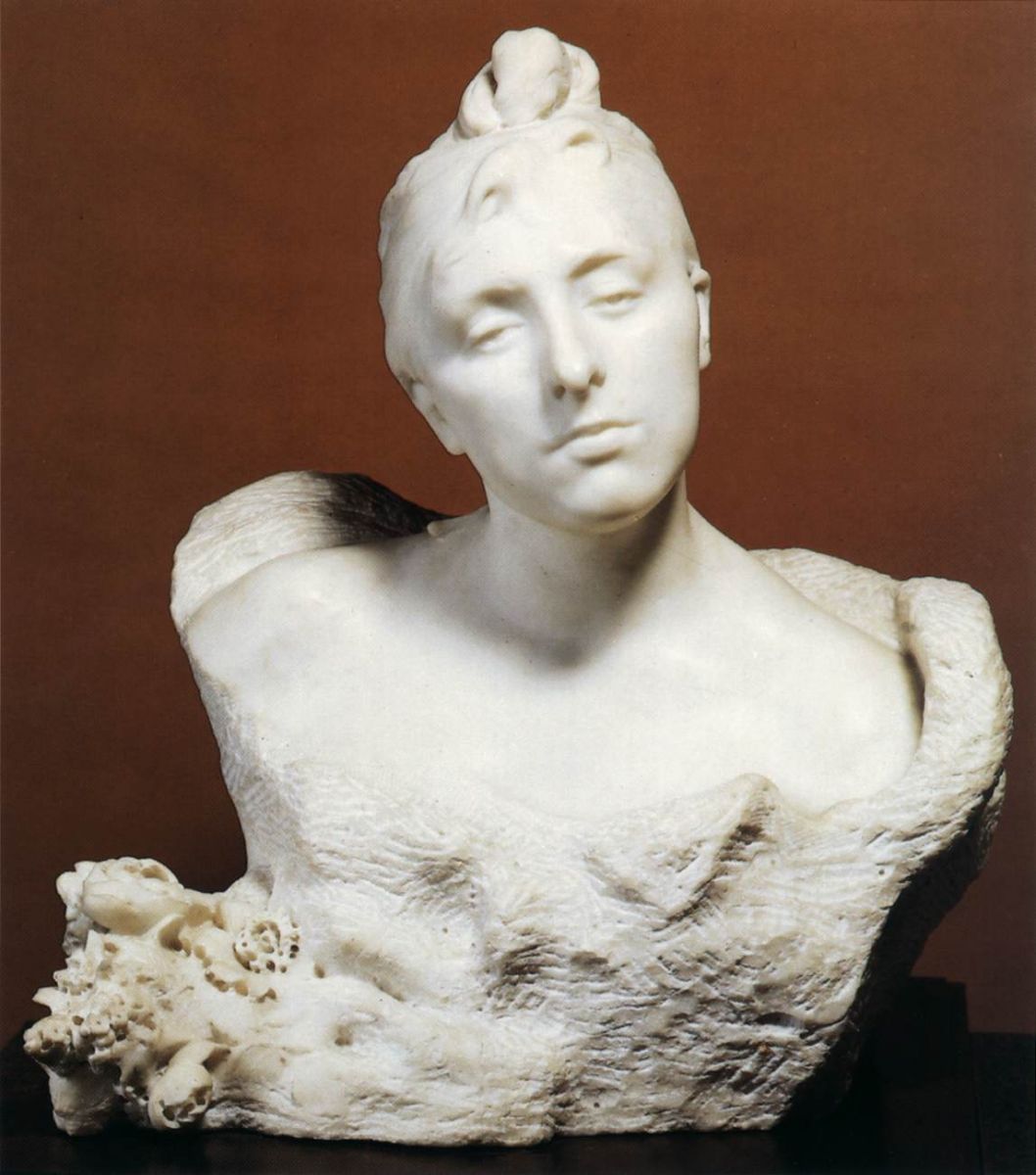 If there was one sculptor of the late 19th century who stands above all others – even though he was only about 5′ 4″ – it is without doubt Auguste Rodin. The consensus is today, and even during his own lifetime, that Rodin was the best sculptor of the era, even though he didn’t do the actual carving.
If there was one sculptor of the late 19th century who stands above all others – even though he was only about 5′ 4″ – it is without doubt Auguste Rodin. The consensus is today, and even during his own lifetime, that Rodin was the best sculptor of the era, even though he didn’t do the actual carving.
Auguste was practicing no deception. When he was alive, everyone who bought an original Rodin knew up front that the bronzes and marbles they were paying good money for were not actually fashioned by Auguste’s own hand. That we express surprise (or indignant disbelief) is due to our own modern-day ignorance of the highly collaborative artistic practices which went into making a sculpture in Auguste’s day and to a large extent today. 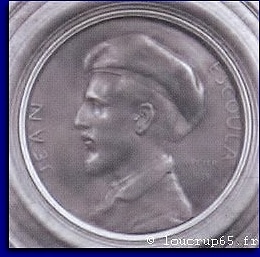
An example of such collaboration is the marble portrait of Luisa Lynch. The Practicien was Jean Escoula, then in his mid-thirties and an independent sculptor in his own right. Jean himself has a number of sculptures in the Musée d’Orsay.
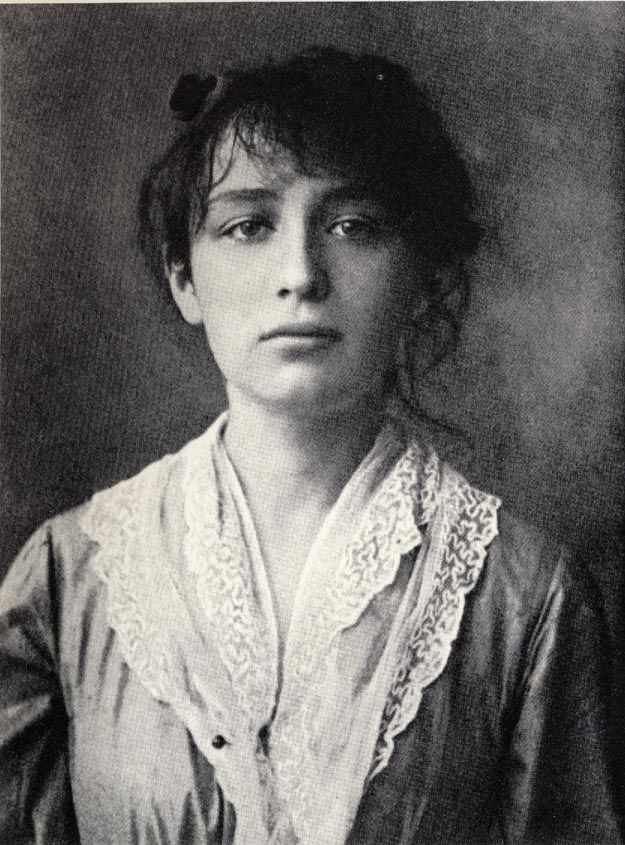
Who were some other practiciens that Rodin hired? The most famous was Camille Claudel. Camille actually liked stone carving and finally became a well known sculptor in her own right.
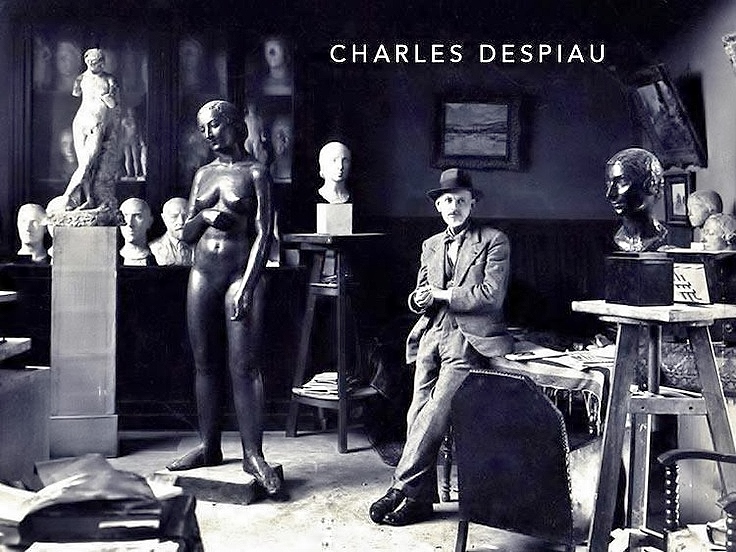 Charles Despiau was another sculptor who went to the Beaux Artes and was exhibiting in art shows when Rodin noticed his work. Rodin hired him as a rough-out artist and “pointer.” He worked for Auguste from l907 until the start of World War I. After the war, Charles kept working as an independent sculptor, and acquired quite a reputation.
Charles Despiau was another sculptor who went to the Beaux Artes and was exhibiting in art shows when Rodin noticed his work. Rodin hired him as a rough-out artist and “pointer.” He worked for Auguste from l907 until the start of World War I. After the war, Charles kept working as an independent sculptor, and acquired quite a reputation.
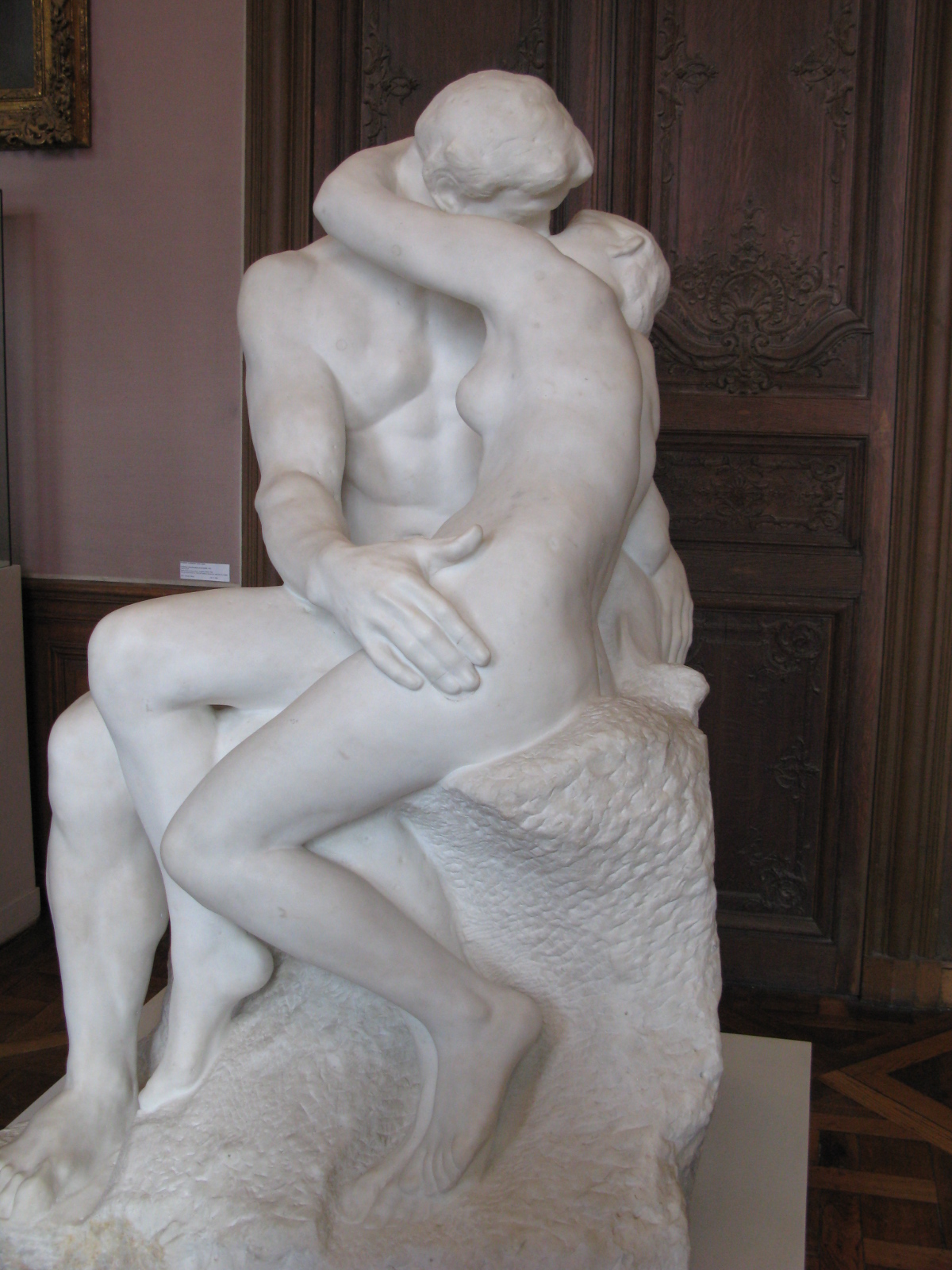 Jean Turcan was a particularly skilled stone sculptor. He carved “The Kiss” that is displayed in the Musée Rodin in the old Hotel Biron where Auguste had one of his studios. Jean was also an independent sculptor who produced a number of his own commissions for the government and ended up getting awarded the Légion d’honneur.
Jean Turcan was a particularly skilled stone sculptor. He carved “The Kiss” that is displayed in the Musée Rodin in the old Hotel Biron where Auguste had one of his studios. Jean was also an independent sculptor who produced a number of his own commissions for the government and ended up getting awarded the Légion d’honneur. 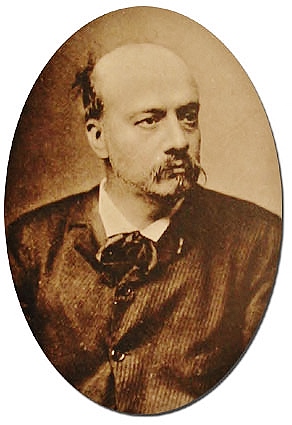
One of Auguste’s most important practiciens was Henri Lebossé (a name Henri later upgraded to “Le Bossé”.) Henri specialized in enlarging (or reducing) sculptures fashioned in clay or plaster. Henri would start his day’s work by sharing a meal with Rodin, typically an omelet made with 10 to 15 eggs accompanied by four or five beefsteaks. This Falstaffian figurehad apersonality between Tartarin and Gargantua. Henri himself claimed Rodin didn’t understand the actual science behind making the sculptures. “Without me,” Henry breezed, “Rodin would have gotten nowhere.” and said flat out it was wrong for Auguste to take all the credit for his work.
OK. So when is a Rodin a Rodin? Too bad we can’t ask Auguste himself. But wait! Amboise Vollard, the famous art dealer (who represented Pablo Picasso) did ask Auguste. Auguste blithely replied, “It’s quite simple. A true Rodin is one that has been done with my consent. The false is done without my knowledge.”
[This is an abbreviated version of a much more informative piece by Chip Cooper of CooperToons at coopertoons.com]

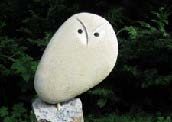

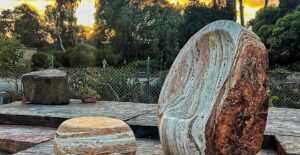


We need some kind of descriptive text here.